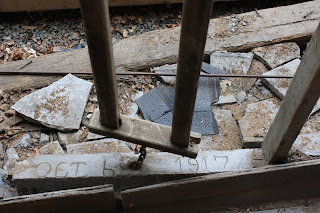So, one of the byproducts of allowing a TV production crew to film on our property was the chance to pick the brains of the psychic mediums who were the stars of the show, which Jenny did.
All three of the mediums were super nice, and loved our house. Two of them had lived previously in early American homes, so they were particularly appreciative. Unfortunately, only one of the three had impressions of the "psychic energy" of our house. The other two were too focused on the readings that they were doing for the show. So, for what it's worth, here is what a professional psychic medium has to say about the house:
In our downstairs guest room, which was being used as the hair and makeup room the for the shoot, the psychic very matter-of-factly communed with the spirit of an old woman named Martha who lived (lives?) there. She apparently was the relative of one of the past owners, and that was her room. Although the psychic said that Martha was friendly and happy, she apparently was something of a neat freak, and was dispensing suggestions as to where the makeup woman should hang up the jacket that she had left sitting on the floor. Martha also seems to have a strong design sensibility, as she told the psychic that the floor should be wood (it is currently wall to wall carpet) and that the walls should not be painted their current bright shade of Baltimore Oriole orange. I have to say, Martha is my kind of spirit. The mess in the guest room annoys the hell out of me, and I am always nagging Jenny to put away the stuff that she "temporarily" stores there. I've also been on a campaign to rip out the carpet and install the same antique wide plank oak flooring that is in the rest of the house. I think that my vote and Martha's outweighs Jenny's, right?
Interestingly, when we had an architectural historian look at that room when we restored it seven years ago, his thought that it was most likely added onto the house in the very early 19th century for a mother-in-law, or spinster aunt or sister. It was too nice for a hired man's room, but not really part of the family area of the main house. I'll have to dig around to see if there is a record of a Martha in the house. I don't recall one, but you never know. In any case, the guest room henceforth will be Martha's room. My sister has already told me that she will never sleep in the room. I'm sure that Martha would prefer that she not intrude, anyway.
The medium also "saw" a nursery in the space between the two upstairs bedrooms that used to be a small third room, that indeed very likely was a nursery. She also had visions of a black woman who served as a nanny in the house, although that would have been very unlikely based on what I know about who lived here long ago. But what do I know? I had never even noticed Martha before.
Anyway, the psychic seems to have dug the vibe of our house, which is really all that we could have hoped for. It certainly beats the alternative, which would have been them telling Jenny that there was a bad energy about the house, at which point she would have begun packing our belongings.





























































